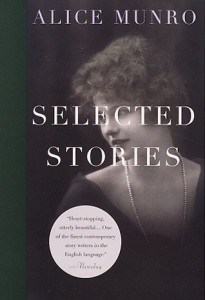A Beginner’s Guide to Alice Munro
by The Millions / Ben Dolnick / November 1, 2013 / No comments
 Considering which of Alice Munro’s stories to read can feel something like considering what to eat from an enormous box of chocolates. There are an overwhelming number of choices, many of which have disconcertingly similar appearances — and, while you’re very likely to choose something delicious, there is the slight but real possibility of finding yourself stuck with, say, raspberry ganache.
Considering which of Alice Munro’s stories to read can feel something like considering what to eat from an enormous box of chocolates. There are an overwhelming number of choices, many of which have disconcertingly similar appearances — and, while you’re very likely to choose something delicious, there is the slight but real possibility of finding yourself stuck with, say, raspberry ganache.
Herewith, a partial guide:
The Munro book to read if you’re only willing to read one: Selected Stories
The Munro book to read if you’re only willing to read one but don’t like the idea of reading a literary greatest hits album: The Beggar Maid. Published in 1977, The Beggar Maid is as close as Munro has ever come to writing a novel, but it actually does a better job than just about any novel I know of getting an entire, living human being onto the page. The book follows a woman named Rose all the way from her early childhood to her middle age, and never feels stretched. It’s an extraordinarily high-grade steak that just happens to be served in slices.
Best story, in the category of autobiographical-seeming stories about love: “Bardon Bus,” which contains some of the most convincingly rendered emotional agony I’ve ever read.
Best story, in the category of historical drama: “A Wilderness Station,” which should, with its many voices and bizarre, dramatic happenings, put to rest any notion of Munro as a predictable dispenser of affair/epiphany-type fiction.
Best story, all categories: “The Beggar Maid,” which showcases, among other things, her remarkable deftness in telling stories that leap around in time.
Story featuring most implausible twist: “Tricks.” A woman falls in love with a man, meets him again and is puzzled by his coldness. Turns out, the cold one was an identical twin. She acknowledges the silliness within the story, but still.
Stories featuring drownings or near-drownings: “Miles City, Montana,” “Changes and Ceremonies,” “Gravel,” “Walking on Water,” “Love of a Good Woman,” “Pictures of the Ice,” “Child’s Play.”
Stories featuring murders or near-murders: “Open Secrets,” “Fits,” “Dimension,” “Free Radicals.”
Story whose plot, after three or four readings, I’m still not sure I understand: “Open Secrets.”
Most depressing story that will somehow leave you uplifted: “Dulse,” in which a woman spends a few days thinking gloomy thoughts in New Brunswick in the wake of a devastating breakup. The brilliant little breakfast scene with the Willa-Cather-obsessed man is a joy.
Most uplifting story that will somehow leave you depressed: “The Turkey Season,” in which the narrator cheerfully remembers the winter she spent working in a turkey barn. A sense of never-quite-resolved unease hovers over this story like a snowstorm.
Authors to read once you’ve finally gotten your fill of Munro: William Maxwell (who’s Munro’s favorite writer), Eudora Welty (whose story, “A Worn Path,” Munro has called the most perfect story ever written), and George Saunders (whose stories, despite very much not being set in rural Canada, are as moving and smart and humane as Munro’s).
Appendix:
Lives of Girls and Women: “Changes and Ceremonies”
Something I’ve Been Meaning to Tell You: “Walking on Water”
The Progress of Love: “Miles City, Montana,” “Fits”
Friend of My Youth: “Pictures of the Ice”
Open Secrets: “A Wilderness Station,” “Open Secrets”
Love of a Good Woman: “Love of a Good Woman”
The Moons of Jupiter: “Turkey Season,” “Bardon Bus”
Runaway: “Tricks”
Too Much Happiness: “Free Radicals,” “Dimension,” “Child’s Play”
This article was originally published by The Millions on July 5, 2012




